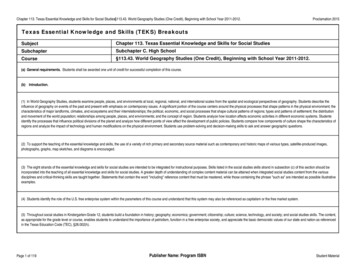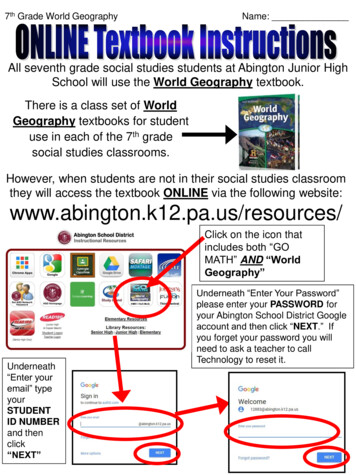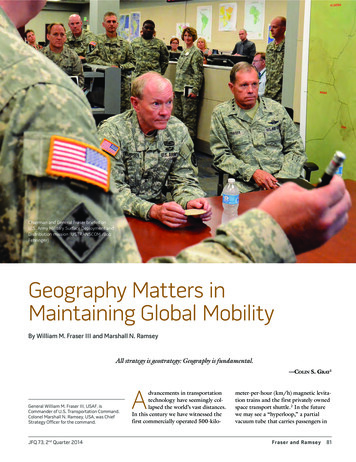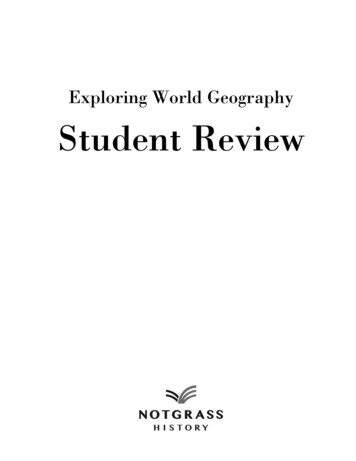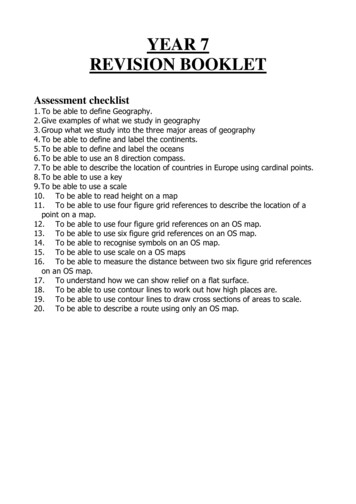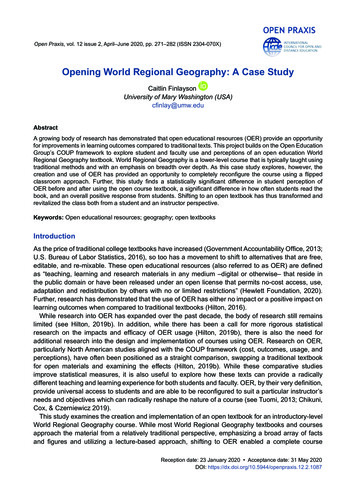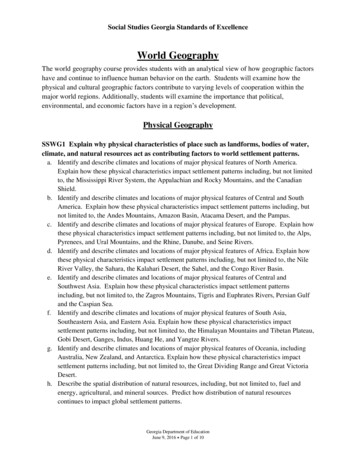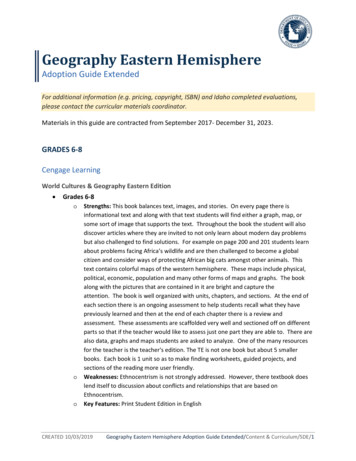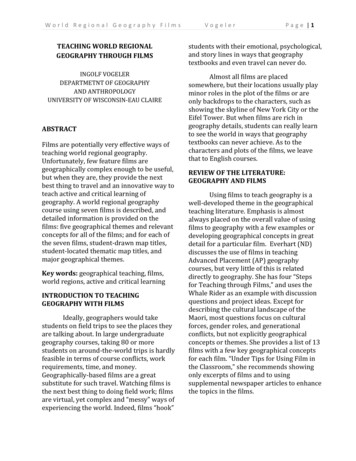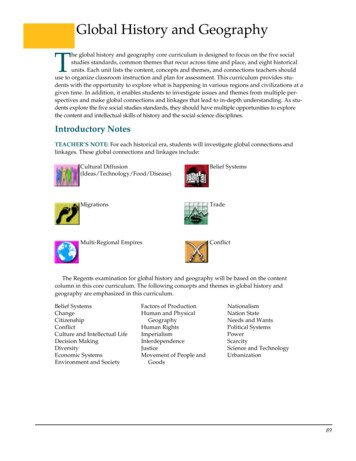
Transcription
Global History and GeographyThe global history and geography core curriculum is designed to focus on the five socialstudies standards, common themes that recur across time and place, and eight historicalunits. Each unit lists the content, concepts and themes, and connections teachers shoulduse to organize classroom instruction and plan for assessment. This curriculum provides students with the opportunity to explore what is happening in various regions and civilizations at agiven time. In addition, it enables students to investigate issues and themes from multiple perspectives and make global connections and linkages that lead to in-depth understanding. As students explore the five social studies standards, they should have multiple opportunities to explorethe content and intellectual skills of history and the social science disciplines.Introductory NotesTEACHER’S NOTE: For each historical era, students will investigate global connections andlinkages. These global connections and linkages include:Cultural Diffusion(Ideas/Technology/Food/Disease)Belief SystemsMigrationsTradeMulti-Regional EmpiresConflictThe Regents examination for global history and geography will be based on the contentcolumn in this core curriculum. The following concepts and themes in global history andgeography are emphasized in this curriculum.Belief SystemsChangeCitizenshipConflictCulture and Intellectual LifeDecision MakingDiversityEconomic SystemsEnvironment and SocietyFactors of ProductionHuman and PhysicalGeographyHuman RightsImperialismInterdependenceJusticeMovement of People andGoodsNationalismNation StateNeeds and WantsPolitical SystemsPowerScarcityScience and TechnologyUrbanization89
Suggested Documents: Throughout the global history and geography core curriculum, teacherswill find lists of suggested documents. In this context, the term “document” includes: books and monographsnewspapers, periodicals, magazines, and scholarly journalsgovernment documentsmanuscripts, archival materials, journals, diaries, and autobiographiesmaps; visual materials (paintings, drawings, sculptures, architectural drawings, films,posters, prints, engravings, photographs, etc.) music artifacts.The suggested documents are indicative of the kinds of primary and secondary sources thatcan be used in a global history and geography program. They do not comprise a mandatory listing but rather represent the kinds of documents that can be used in document-based questions.In a few cases, specific websites for listed documents are included. Afuller listing of websitescan be found in the Appendix of this document.90
Content reviews were provided by Dr. Jo Margaret Mano, Department of Geography, StateUniversity of New York, New Paltz, Dr. Ronald G. Knapp, Professor and Chair, Department ofGeography, State University of New York, New Paltz, D. Joseph Corr, Shaker High School, Latham,New York, and Steven Goldberg, New Rochelle Central School District, New Rochelle, New York.91
METHODOLOGY OF GLOBAL HISTORY AND y1. Skills of historical analysisa. Investigate differing and competing interpretations of historical theories—multiple perspectivesb. Hypothesize about why interpretations change over timec. Explain the importance of historical evidence2. Understand the concepts ofchange and continuity over time3. The connections and interactionsof people across time and space4. Time frames and periodization5. Roles and contributions of individuals and groups6. Oral histories1,2Belief rsityHuman ationConnectionsTEACHER’S NOTE: This introductoryunit is designed to introduce students tothe five social studies standards and theessential questions associated with eachstandard. Many teachers may choose toinfuse this introduction into the body ofthe course.TEACHER’S NOTE: While this core curriculum presents a chronologicalapproach to global history and geography, it may be necessary at times to suspend chronology. In some instances,events overlap historical eras. An example would be European feudalism thathas been placed in UNIT TWO:Expanding Zones of Exchange andEncounter (500-1200); Japanese feudalismis placed in UNIT THREE: GlobalInteractions (1200-1650). The teacher maywish to place Japanese feudalism inUNIT TWO with European feudalism sothat students can better compare andcontrast the two. This is a local curriculum decision.TEACHER’S NOTE: Over this two-yearcourse of study, students should developa sense of time, exploring different periodization systems and examining themesacross time and place. This ability is critical in understanding the course andbeing able to make the fundamental connections and linkages.
METHODOLOGY OF GLOBAL HISTORY AND GEOGRAPHY, continuedContentStandardsConcepts/ThemesB. Geography1. Elements of geographya. Human geographyb. Physical geographyc. Political geographyd. Migratione. Tradef. Environment and societyg. The uses of geography2. Critical thinking skillsa. Asking and answeringgeographic questionsb. Analyzing theories ofgeographyc. Acquiring, organizing, and analyzing geographic information3. Identifying and defining worldregions3Human/PhysicalGeographyMovement ofPeople andGoodsEnvironmentand SocietyChangeNeeds andWantsInterdependenceCultureC. Economics1. Major economic concepts (scarcity,supply/demand, opportunitycosts, production, resources)2. Economic decision making3. The interdependence of economicsand economic systems throughoutthe world4. Applying critical thinking skills inmaking informed and well-reasoned economic decisionsD.Political science1. The purposes of government2. Political systems around the world3. Political concepts of power,authority, governance, and law4. Rights and responsibilities of citizenship across time and space5. Critical thinking skillsa. Probing ideas and assumptionsb. Posing and answering analytical questionsc. Assuming a skeptical attitudetoward questionable politicalstatementsd. Evaluating evidence and forming rational conclusionse. Developing participatory skills45ConnectionsTEACHER’S NOTE: Prior to the completion of the two-year global history andgeography program, students shouldhave a clear understanding of the humanand physical geography. They shouldhave multiple opportunities to explorethe impact of geography on the past andpresent. Students should be able to make,use, and apply geographicgeneralizations. They should be able touse data to construct maps, graphs,charts, etc.- What impact does geography have onhistory?- How do physical and human geographyaffect people and places?- To what extent are terms such as “FarEast” and “Middle East” a reflection of aEuropean perspective on regions?EconomicTEACHER’S NOTE: Students should beSystemsable to apply the three basic questions ofDecisioneconomics to situations across time andMakingplace.Factors of- What goods and services shall beProductionproduced and in what quantities?Interdependence - How shall goods and services beNeeds andproduced?Wants- For whom shall goods and services beScarcityproduced?Science andTechnology- What are the basic purposes of government?Decision- What assumptions have different groupsMakingmade regarding power, authority, goverJusticenance, and law across time and place?Nation State- How is citizenship defined and how doCitizenshipdifferent societies view the rights andPolitical Systems responsibilities of citizenship?Power- How do concepts of justice and humanNationalismvalues differ across time and place?- How are decisions made under differentpolitical systems?93
UNIT ONE: ANCIENT WORLD—CIVILIZATIONS AND RELIGIONS(4000 BC - 500 AD)ContentA.Early peoples1. Human and physical geography2. Hunters and gatherers—nomadicgroups3. Relationship to the environment4. Migration of early humanpopulationsa. Out of Africab. Other theories5. Early governmenta. Purposesb. Decision makingc. Move toward more complexgovernment systemsB. Neolithic Revolution and early rivercivilizations1. Compare and contrast(Mesopotamia, Egypt, the IndusValley, and Yellow Rivercivilizations)a. Human and physicalgeography of early hemesHuman/PhysicalGeographyMovement ofPeople andGoodsScarcityNeeds andWantsConnections- What was the relationship betweenearly peoples and their environment?- What reasons can you pose to explainwhy early peoples migrated from placeto place?- What does the use of tools tell us abouta society?EnvironmentPolitical gyTEACHER’S NOTE: Throughout globalhistory, students should know and beable to analyze critical turning points inhistory. They should be able to explainhow technological change affects people,places, and regions.TEACHER’S NOTE: When studyingearly river civilizations, students investigate at least two civilizations in depth. Itis not necessary that all civilizations beaddressed to the same extent. The modelpresented here for the study of earlyriver civilizations can be used in thestudy of any civilization. Students shouldbe able to analyze important ideas, socialand cultural values, beliefs, andtraditions.- Why was the introduction of agriculturereferred to as the Neolithic Revolution?Why was this a turning point?- What political systems developed inearly river civilizations?- How was the rise of cities related to theNeolithic Revolution and thedevelopment of early civilizations?
UNIT ONE: ANCIENT WORLD—CIVILIZATIONS AND RELIGIONS (4000 BC - 500 AD), continuedContentb. Traditional economiesc. Political systemsd. Social structures andurbanizatione. Contributions1) Writing systems2) Belief systems3) Early technology—irrigation,tools, weapons4) Architecture5) Legal systems—Code ofHammurabi2. Identify demographic patterns ofearly civilizations and movementof people—Bantu migration (500BC - 1500 AD)a. Human and physicalgeographyb. Causes of migrationc. Impact on other areas of AfricaC. Classical civilizations1. Chinese civilizationa. Human and physicalgeographyb. Chinese contributions (engineering, tools, writing, silk,bronzes, government system)c. Dynastic cyclesd. Mandate of Heaven2. Greek civilizationa. Human and physicalgeographyb. The rise of city-states—Athens/Spartac. Contributions: art, architecture,philosophy, science—Plato,Socrates, Aristotled. Growth of democracy in Athensversus the Spartan politicalsysteme. Alexander the Great andHellenistic 3,4,5Concepts/ThemesEconomicSystemPolitical SystemCultural andIntellectualLifeDecisionMakingScience andTechnologyJusticeCulture ltural/IntellectualLifePolitical SystemsConnections- What is meant by the term “traditionaleconomy”?- In what ways have science and technology helped humankind meet its basicneeds and wants?Suggested Documents: Timelines, photographs and/or models of temples, pictures of artifacts, palaces, and neolithicvillages; record-keeping systems;creation stories such as The Epic ofGilgamesh- What caused the Bantu to migratesouth and east from their west Africanorigins?- How did this migration change subSaharan Africa?TEACHER’S NOTE: Have studentsdevelop timelines and maps to illustratethe parallel development of classicalcivilizations.- What have been the contributions ofclassical civilizations to the history ofhumankind?- What forces caused the rise and fall ofclassical civilizations?- What were the status and role ofwomen in these civilizations?- What was the Mandate of Heaven?Why did the Chinese define their history in terms of dynastic cycles?- How are contemporary democratic governments rooted in classical traditions?- What impacts did Greece and Romehave on the development of later political systems?- How did geography affect the rise ofcity-states in Greece and the rise of theRoman Empire?- How did the institution of slavery fit withinthe Athenian concept of democracy?95
UNIT ONE: ANCIENT WORLD—CIVILIZATIONS AND RELIGION (4000 BC - 500 AD), contin uedContent3. Roman Republica. Human and physicalgeographyb. Contributions—law (TwelveTables), architecture, literature, roads, bridges4. Indian (Maurya) Empirea. Human and physicalgeography (monsoons)b. Contributions—governmentsystem5. Rise of agrarian civilizations inMesoamerica—Mayan (200 BC 900 AD)a. Human and physicalgeographyb. Contributions (mathematics,astronomy, science, arts,architecture, and technology)c. Role of maized. Religion6. The status and role of women inclassical civilizations7. The growth of global trade routesin classical civilizationsa. Phoenician trade routesb. Silk Roadc. Maritime and overland traderoutes1) Linking Africa and Eurasia2) Linking China, Korea, andJapanD.The rise and fall of great empires1. Han Dynastya. Human and physicalgeographyb. Factors leading to growthc. Contributionsd. Causes of declinee. Role of migrating nomadicgroups from Central Asia2. Roman Empire96StandardsConcepts/ThemesDecision hyFactors ofProductionNeeds andWantsBelief SystemsCulture andIntellectual LifeMovement ofPeople ural andIntellectual LifeMovement ofPeople andGoodsTechnologyPowerConnectionsSuggested Documents: Hammurabi’sCode, Hebrew law, the Twelve Tables ofRome ables.html), theGolden Rule, The Odyssey, Ptolemaicmaps, for Ashoka of the Maurya Empiresee .html- What impact did monsoons have on thehistoric and economic development ofthe sub-continent?TEACHER’S NOTE: The Mayan civilizations span the time period and are placedhere to introduce students to developments in the Western Hemi-sphere froman early date.- How did agriculture arise in theAmericas?- What were the earliest crops in theAmericas?- How did the Mayan civilizations compare to river valley and classicalcivilizations of Eurasia?- How did the decline of the Mayanscompare to the fall of the Han andRoman empires?- What brought about the decline of theMayans?TEACHER’S NOTE: The study of economics includes the investigation ofinterdependent economies throughoutthe world over time and place. Studentsshould be able to trace the maritime andoverland trading routes that linked civilizations and led to interdependence andcultural diffusion.- Why did the Silk Road extend fromKorea across Central Asia?- What goods were being traded? Why?Suggested Documents: Maps of classicalcivilizations and early trade routes- What caused the fall of the Han andRoman empires?- What role did migrating nomadicgroups play in the fall of the Han andRoman empires?
UNIT ONE: ANCIENT WORLD—CIVILIZATIONS AND RELIGION (4000 BC - 500 AD), sa. Human and physicalgeographyb. Factors leading to growth (engineering, empire building, trade)c. Contributionsd. Causes of declinee. Role of migrating nomadicgroups from Central Asiaf. Pax RomanaE. The emergence and spread of beliefsystems1. Place of origin and major beliefsa. Animism—Africanb. Hinduismc. Buddhismd. Chinese philosophies(Confucianism, Daoism)e. Judaismf. Christianityg. Islamh. Legalismi. Shintoismj. Jainism2. Expansion of Christianity, Islam,Confucianism, and BuddhismBelief tural andIntellectualLifeTEACHER’S NOTE: When analyzing theworld’s major religions and philosophies,it may be best to suspend a strict adherence to chronology in favor of comprehensively exploring belief systems as a theme.On the other hand, you may teach thissubject in its historical context. This studyinvolves learning about the importantroles and contributions made by individuals and groups. It is important to makelinkages to the present.- In what ways are these varying beliefsystems similar and different?- How do these belief systems affect ourlives today?- In what ways does a culture’s arts reflectits belief system?- What individuals and groups are associated with the major religions of theworld?- What holy books or texts are associatedwith the major religions of the world?- What role did missionaries, traders, andconquerors play in the spread of religions?- How did the expansion of Islam,Confucianism, Christianity, andBuddhism encourage the encounter andexchanges of peoples, goods, and ideas?Suggested Documents: Maps showingspread of religions, Old Testament, Torah,New Testament, the Lawbook of Manu:the Caste System, the Bhagavad-Gita, Lifeof Buddha, the Analects, Daoist poems,the Koran (Qur’an), Confucius, Analectshttp://www.wsu.edu:8080/ wldciv/world civ reader/world civ reader 1/confucius.html97
UNIT TWO: EXPANDING ZONES OF EXCHANGE AND ENCOUNTER(500 - 1200)ContentA.Gupta Empire (320-550 AD)1. Human and physical geography2. Artistic, scientific, andmathematical contributions3. Ties to Hinduism4. Organizational structureB. Tang and Song Dynasty (618-1126 AD)1. Human and physical geography2. Contributions3. Chinese influence on Korea andJapan4. Cultural flowering5. Growth of commerce and tradeC. Byzantine Empire (330-1453 AD)1. Human and physical geography2. Achievements (law—JustinianCode, engineering, art, andcommerce)3. The Orthodox Christian Church4. Political structure and JustinianCode5. Role in preserving and transmitting Greek and Roman cultures6. Impact on Russia and EasternEuropeD.Early Russia1. Human and physical geography2. Trade3. Kiev4. Russian Orthodox ChurchE. The spread of Islam to Europe, Asia,and Africa1. Human and physical geography2. Organizational alGeographyCultural andIntellectual Life2,32,3,4,5Human/PhysicalGeographyCultural andIntellectual yJusticeBelief �S NOTE: Students should beable to interpret and analyze documentsand artifacts related to global history.Using graphic organizers, they can compare and contrast civilizations.- What contributions to human historyhave been made by the Gupta Empire,the Tang and Song Dynasty, ByzantineEmpire, and medieval Europe?- What role did women play in the GuptaEmpire? the Tang and Song Dynasty?Suggested Documents: Photographs ofGupta, Tang, and Song arts; remains ofmaterial culture; timelines; and mapsTEACHER’S NOTE: Students shouldunderstand the development and connectedness of civilizations and cultures.The study of the Byzantine Empire isparticularly suited to this approachbecause it encompasses lands from morethan one region.- What role did the Byzantine Empireplay in the preservation and transmission of Greek and Roman knowledgeand culture? of Roman concept of law?- What impact did the Byzantine Empirehave in the development of historicalRussia? of Russia today?- What impact did the fall ofConstantinople (1453) have on WesternEurope? To what extent was this event aturning point in global history?- How did the location of Constantinoplemake it a crossroads of Europe and Asia?- How did geography affect early Russia?Suggested Documents: Justinian Code,pictures of Hagia Sophia, mosaics,reservoirs, etc.TEACHER’S NOTE: Through theirinquiry, students should gain an appreciation for the vastness of the variousMuslim empires, the ability of Islam to
UNIT TWO: EXPANDING ZONES OF EXCHANGE AND ENCOUNTER (500 - 1200), continuedContent3. The development of Islamic lawand its impact4. Social class: women and slavery inMuslim society5. Position of “people of the book”6. The golden age of Islama. Contributions to mathematics,science, medicine, art, architecture, and literatureb. Role in preserving Greek andRoman culturec. Islamic Spain7. TradeF. Medieval Europe (500-1400)1. Human and physical geography2. Frankish Empire—Charlemagne3. Manorialism4. Feudalisma. Social hierarchy andstratificationb. Role of men and women5. Spiritual and secular role of theChurch6. Monastic centers of learning7. Anti-Semitism8. Art and architectureG.Crusades1. Causes2. Impacts on Southwest Asia,Byzantium, and Europe3. Perspectives4. Key individuals—Urban II,Saladin, and Richard the rdependenceDiversityJustice andHuman RightsPolitical SystemsEconomicSystemsBelief Systems2Cultural andIntellectual LifeScience andTechnology2,3,4,52,3,4EconomicSystemsFactors ofProductionPolitical SystemsBelief nterdependenceMovement ofPeople andGoodsNeeds and WantsScience andTechnologyConflictConnectionssuccessfully rule very diverse populations, and the role of Islam in culturalinnovation and trade.- What contributions did Islamic culturemake to global history?- What was the status of women underIslamic law?- How did Islam link Eastern andWestern cultures?- What was the role of Islamic missionaries in Africa? in other regions?- How did Islam art and architecturereflect a blend of many differentcultures?Suggested Documents: Maps showingtrade in and around the Indian Oceanand Central Asia, Islamic art andarchitecture, and calligraphy- What assumptions did medievalEurope make regarding power, authority, governance, and law?- How did the roles of men and womendiffer in medieval society?- What role did individual citizens playin feudal society?- How were decisions made about the useof scarce resources in medieval Europe?- What principles were the basis of thesedecisions?Suggested Documents: Photographs andarchitectural drawings, details of paintings showing everyday life, diagramsand charts of monasteries and manors,and diagrams of social pyramidsTEACHER’S NOTE: Students should beable to analyze the causes of the Crusadesand their impact. They should understandthe diverse ways Muslims, Byzantines,and Christians viewed this period. Theyshould appreciate that one dimension of asociety’s growth is its connection toneighboring and competing societies.Students should explore how places havetaken on symbolic meaning throughouthistory, e.g., Jerusalem as a holy city.Suggested Documents: Portolan charts,various kinds of other maps, and firsthand accounts99
UNIT THREE: GLOBAL INTERACTIONS (1200 - 1650)ContentStandardsConcepts/ThemesA.Early Japanese history and feudalism1. Human and physical geography2. Early traditions (Shintoism)3. Ties with China and Korea:cultural diffusion, Buddhism, andConfucianism4. Tokugawa Shogunate5. Social hierarchy and stratification6. Comparison to European feudalism7. Zen Buddhism1,2,3,4,5Human/PhysicalGeographyPolitical SystemsCultural andIntellectual LifeB. The rise and fall of the Mongols andtheir impact on Eurasia1. Human and physical geography2. Origins—Central Asian nomadictribes3. The Yuan Dynasty: a foreign nonChinese dynasty4. Extent of empire under GhengisKhan and Kublai Khan5. Impact on Central Asia, China,Korea, Europe, India, Southwest Asia6. Impact on the rise of Moscow7. Interaction with the West andglobal trade, Pax Mongolia (e.g.,Marco Polo)8. Causes of decline2,3,4,5C. Global trade and interactions1. Resurgence of Europea. Hanseatic League and Italiancity-statesb. Trade fairs and townsc. Medieval guildsd. Commercial revolution2. Major trading centers—Nanjing/Calicut/Mogadishu/Venice3. Ibn Battuta4. Expansion of the Portuguese spicetrade to Southeast Asia and itsimpact on Asia and Europe2,3,4100ConnectionsTEACHER’S NOTE: Students should beable to compare and contrast the social,political, and economic dimensions of theJapanese and European feudal systems.They should understand the impact ofcultural diffusion on Japanese culture.Additional case studies might includeBelief SystemsChinese and Korean feudalism.- How are Japanese and Europeanfeudalism similar? dissimilar?- How did location impact Japanesehistory?Suggested Documents: The Way of Samurai,and other literary works; materials onKabuki theatre; Japanese wood-blockprints; diagrams of the social systemTEACHER’S NOTE: Students should underHuman/stand the development and connectednessPhysicalof civilizations and cultures. They shouldGeographyInterdependence understand the global significance and greatdiversity encompassed by the MongolDiversityEmpire. This era saw the growing imporUrbanizationtance of cities as centers of trade and culture.Movement ofPeople and- How did geography contribute to theGoodssuccess of the Mongols?Conflict- What forces led to the rise and fall of theMongols?- How were a nomadic people able to conquer more advanced civilizations?- Why was the Mongol defeat in Japansignificant?- How did the Mongols in China change?Suggested Documents: Descriptions ofMongols by such travelers as Marco Polo(see tml) and others;Economicvisuals, mapsSystemsTEACHER’S NOTE: Students should beChangeable to trace the rise and evolution of capiUrbanizationtalism as an economic system. TheyFactors ofshould understand that capitalism wasProductionmade possible by changes within theMovement ofEuropean economic system and byPeople andoverseas expansion.- What was the relationship between theGoodsrise of capitalism and the decline offeudalism?- What role did a class of merchants andbankers play in the rise of capitalism?
UNIT THREE: GLOBAL INTERACTIONS (1200 - 1650), continuedContentStandardsConcepts/ThemesD.Rise and fall of African civilizations:Ghana, Mali, Axum, and Songhaiempires1. Human and physical geography2. Organizational structure3. Contributions4. Roles in global trade routes5. Spread and impact of Islam—Mansa Musa6. Timbuktu and African temsChangeUrbanizationBelief SystemsMovement ofPeople andGoodsE. Social, economic, and politicalimpacts of the plague on Eurasia andAfrica2,3,4,5Human/PhysicalGeographyChangeF. Renaissance and humanism1. Human and physical geography2. Shift in worldview—otherworldly to secular3. Greco-Roman revival (interest inhumanism)4. Art and architecture (e.g., da Vinciand Michelangelo)2,3,5Human/PhysicalGeographyCultural andIntellectualLifeScience andTechnologyConnections- In a market economy, how does thesystem determine what goods and services are to be produced and in whatquantities? and for whom?- How did a capitalist economy changethe way men and women worked?- Why did cities like Venice andMogadishu become trading centers?- What were the major land and sea traderoutes of the early 1400s?- What goods were being traded?Suggested Documents: Maps, descriptionsof medieval guilds, town charters, journalsTEACHER’S NOTE: Students shouldstudy development and interactions ofsocial/cultural/political/economic/ religious systems in different regions of theworld.- What role did African kingdoms play inoverland and maritime trade routes ofthe era?- What impact did Islam have on thesekingdoms?- What forces contributed to the rise andfall of African kingdoms? How did theycompare with the rise and fall of otherempires?- How did traditional art reflect thebeliefs of African kingdoms?Suggested Document: Leo Africanus;Description of Timbuktu from TheDescription of Africa see http://www.wsu.edu:8080/ wldciv/world civ reader/world civ reader 2/leo africanus.html- What role did the plague play in majordemographic and social shifts inEurasia and Africa?Suggested Documents: Maps showingthe global spread and extent of theplague, written accounts by Europeansand others (Jean deVenette; Ibn al-wardi;Giovanni Boccaccio, The Decameron)TEACHER’S NOTE: Students shouldunderstand that the Renaissance represented a shift from the emphasis on spiritual concerns in the medieval period tomore secular ones. Humanism emphasized the importance of individual worthin a secular society.- What impact did capitalism have on theRenaissance?101
UNIT THREE: GLOBAL INTERACTIONS (1200 - 1650), continuedContentStandards5. Literature (e.g., Dante, Cervantes,Shakespeare)6. Political science (e.g., Machiavelli)7. New scientific and technologicalinnovations (Gutenberg’smoveable type printing press,cartography, naval engineering,and navigational and - How did the Renaissance differ from themedieval period? How was it similar?Suggested Documents: Diagrams of theprinting press; nautical devices; mapsand historical atlases—the historic mapsof Ptolemy, Abraham Ortelius, GerardusMercator, Johann Blaeu, Georg Braun,and Franz Hogenberg; Renaissance art;excerpts from Renaissance literature;Machiavelli, The Prince; works by Dante,Cervantes, and ShakespeareTEACHER’S NOTE: Students should beprovided with opportunities to look atissues from multiple perspectives (e.g.,the conflict between the Roman CatholicChurch and secular rulers, nationalism,and the unifying role of the RomanCatholic Church). The Reformation challenged the traditional power and authority of the Roman Catholic Church.Students should analyze different kindsof maps of Europe during this timeperiod.- How did religious reform lead toconflict? To what extent were theseconflicts resolved?- What role did Elizabeth I play in theEnglish Reformation?Suggested Documents: Exerpts fromShakespeare, The Merchant of Venice;Martin Luther, The Ninty-five Theses,Loyola, Spiritual Exercise- What forces led to the rise of nationstates?- In what ways did nationalism supportcentralized governments headed bypowerful rulers?- What forces opposed absolutemonarchies?- How did nationalism lead to conflictbetween secular and ecclesiasticalpowers?Suggested Documents: Different kinds ofmaps including Ptolemaic, Mercator,Blaeu, Braun, and Hogenberg, andOrtelius; pictures of citiesG.Reformation and CounterReformation1. Human and physical geography2. Martin Luther’s Ninety-Five Theses:the challenge to the power andauthority of the Roman CatholicChurch3. Anti-Semitic laws and policies4. Henry VIII and the EnglishReformation5. Calvin and other reformers6. Counter Reformation (IgnatiusLoyola, Council of Trent)7. Roles of men and women withinthe Christian churches8. Religious wars in
B. Geography . 3 H u m a n / P h y s i c a l TEACHER’S NOTE: Prior to the comple-1. Elements of geography . Geography tion of the two-year global history and a. Human geography . Movement of . geography program, students should . b. Physical geography . People and have a clear understanding of the human

